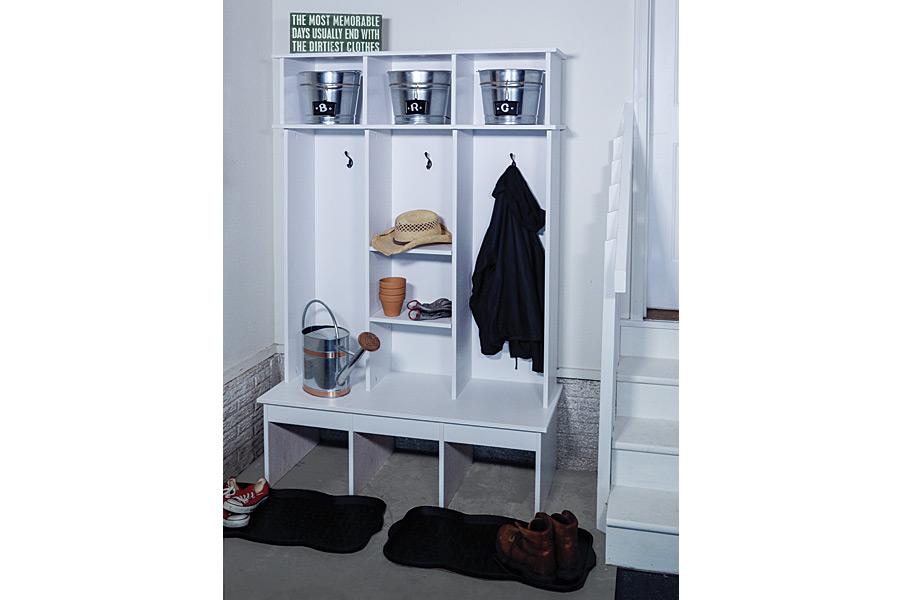
Deze organizer voor in de hal is perfect voor het opbergen van jassen, hoeden, handschoenen en meer, en helpt rommel in toom te houden terwijl u er stijlvol uitziet. U kunt er gemakkelijk zelf een bouwen met slechts een paar basisgereedschappen, wat multiplex, een enkele plank en betaalbare mallen. Als u verstelbare planken wilt toevoegen, kunt u een plank-pin-mal (19,05 mm of 3/4") kunt u dit eenvoudig doen.
Materialen
Houtproducten
2 Multiplex, 3/4" (19,05 mm) x 48" (1219,2 mm) x 96" (2438,4mm)
1 Multiplex, 3/4" (19,05 mm) x 48" (1219,2 mm) x 48" (1219,2mm)
1 bord, 1x4 (25,4 mm x 101,6 mm) x 48" (1219,2mm)
6 Schermvormen, 1/4" (6,35 mm) x 3/4" (19,05 mm) x 96" (2438,4mm)
Hardware en benodigdheden
1241 1/4" (6,35 mm) grofdraad Kreg Pocket-Hole-schroeven
42" (50,8 mm) houtschroeven met platte kop
501" (25,4 mm) 18-gauge brad-spijkers
121/4" (31,75 mm) plankpennen
3 Kapstokhaken
1 Houtlijm
Snijlijst en onderdelen

4 Bank rechtop, 3/4" (19,05 mm) x 19 1/4" (489 mm) x 15 3/4" (400mm)
3 Bankrug, 3/4" (19,05 mm) x 14" (355,6 mm) x 10" (254mm)
3 Bankrail, 3/4" (19,05 mm) x 3 1/2" (88,9 mm) x 14" (355,6mm)
1 Bankzitting, 3/4" (19,05 mm) x 20" (508 mm) x 46 1/2" (1181,1mm)
4 Locker Staander, 3/4" (19,05 mm) x 11 3/4" (298,5 mm) x 46 1/2" (1181,1mm)
3 Locker Terug, 3/4" (19,05 mm) x 14" (355,6 mm) x 46 1/2" (1181,1mm)
1 Locker Top, 3/4" (19,05 mm) x 13 1/2" (342,9 mm) x 46 1/2" (1181,1mm)
3 Lockerplank, 3/4" (19,05 mm) x 11" (279,4 mm) x 13 7/8" (352,4mm)
4 Cubby-staanders, 3/4" (19,05 mm) x 12 3/4" (323,9 mm) x 11 3/4" (298,5mm)
3 Cubby-rug, 3/4" (19,05 mm) x 14" (355,6 mm) x 11 3/4" (298,5mm)
1 Cubby-top, 3/4" (19,05 mm) x 13 1/2" (342,9 mm) x 46 1/2" (1181,1mm)
24 Voorkantrand, 1/4" (6,35 mm) x 3/4" (19,05 mm) x op maat gesneden


Routebeschrijving
Maak de bankstaanders

Zaag vier bankstaanders op maat van 3/4" (19,05 mm) multiplex, zoals weergegeven in het snijdiagram. Met uw Kreg® Pocket-Hole Jig ingesteld voor 3/4" (19,05 mm) dik materiaal, boor pocketgaten waar aangegeven. Let op dat u twee "paren" staanders gaat maken.
Tip: Zet het beste gezicht naar buiten
Wanneer u multiplex koopt, heeft het meestal één zijde die er beter uitziet dan de andere. Wanneer u dit project bouwt, plaatst u de pocket holes in de minder aantrekkelijke zijde. De mooiere zijde is degene die zichtbaar is, dus door uw pocket holes op deze manier te positioneren, zal de mooiste zijde van elk multiplex onderdeel het meest zichtbaar zijn.
Maak de bankruggen

Zaag drie bankruggen op maat van 3/4" (19,05 mm) multiplex, zoals weergegeven in het snijdiagram. Boor pocketgaten waar aangegeven. Let bij het boren van deze pocketgaten op dat de pocketgaten langs de zijkanten versprongen zijn. Dat is zodat de schroeven niet in elkaar lopen wanneer u de bank later in elkaar zet.
Maak de bankrails

Zaag drie Bench Rails op maat van een 1x4 (25,4 mm x 101,6 mm) plank, zoals getoond in het snijdiagram. Boor pocketgaten waar aangegeven. Deze drie Rails zijn allemaal identiek.
Monteer de bankbasis

Schuur de onderdelen glad en monteer vervolgens de bankbasis, zoals afgebeeld. Om dat te doen, bevestigt u de bankrails en bankruggen aan de bankstaanders met behulp van 1 1/4" (31,75 mm) grofdraad Kreg Pocket-Hole-schroeven. Zorg ervoor dat alle onderdelen goed zijn georiënteerd voordat u de schroeven erin draait.
Maak de bankzitting

Zaag een werkblad op maat van 3/4" (19,05 mm) multiplex, zoals afgebeeld in het snijdiagram. Schuur vervolgens de Bench Seat glad. Nu kunt u de Bench Seat bevestigen, zoals afgebeeld. Lijn de Seat uit zodat deze 3/4" (19,05 mm) aan de voorkant en uiteinden. Bevestig vervolgens de zitting met behulp van 1 1/4" (31,75 mm) grofdraad Kreg Pocket-Hole-schroeven.
Maak de kluisstaanders

Zaag vier Locker-staanders op maat van 3/4" (19,05 mm) multiplex, zoals weergegeven in het snijdiagram. Selecteer twee als de linker en rechter "buitenste" staanders. Boor pocketgaten waar aangegeven.
Maak de Locker-staanders compleet

De andere twee Locker Uprights zijn de "binnenste" Uprights. Boor dezelfde pocketgaten in deze binnenste staanders. Om verstelbare planken toe te voegen, gebruik je een Kreg Shelf Pin Jig om plankpengaten te boren, zoals afgebeeld. Het voordeel van de Shelf Pin Jig is dat het makkelijk is om consistente plankafstanden te krijgen, zodat je vlakke, wiebelvrije planken hebt.
OPMERKING:
Kreg Shelf Pin Jig: Belangrijkste verschillen tussen modellen van de eerste en tweede generatie
Bij het gebruik van de Kreg Shelf Pin Jig is het belangrijk om de setback-afstand (afstand van de rand tot de shelf-pin-gaten) in acht te nemen. De getoonde afstand komt overeen met de eerste generatie Kreg Shelf Pin Jig. Het model van de tweede generatie, gelanceerd in maart 2022, heeft echter een bijgewerkte setback-afstand. Ondanks dit verschil is de verticale afstand tussen shelf-pin-gaten—1 1/4" (31,75 mm)—blijft voor beide modellen identiek. Dit zorgt ervoor dat u nauwkeurige plank-pin gaten kunt maken met zowel de eerste- als tweede-generatie mal.
Voor nauwkeurige resultaten kiest u de Kreg Shelf Pin Jig die bij uw project past, wetende dat beide generaties een consistente verticale afstand leveren.
Hoe maak je de Locker Backs

Knip drie Locker Backs uit 3/4" (19,05 mm) multiplex volgens de afmetingen in het snijdiagram. Boor pocketgaten zoals aangegeven in het diagram, waarbij u er rekening mee houdt dat de pocketgaten langs de zijkanten versprongen zijn. Dit zorgt voor een goede uitlijning tijdens de montage en een schone, veilige pasvorm voor uw project.
Hoe maak je de bovenkant van het kluisje?

-
Snij de bovenkant van het kluisje open: Begin met het knippen van een Locker Top van 3/4" (19,05 mm) multiplex, volgens de afmetingen in het zaagdiagram.
-
Gaten boren: Boor vier gaten bij de voorkant van de Locker Top zoals weergegeven in het diagram. Deze gaten bevestigen later het bovenste hokgedeelte aan de lockers.
-
Maak de planken klaar: Terwijl je bezig bent, knip je vier Locker-planken op maat uit dezelfde 3/4" multiplex.
-
Finish: Schuur het bovenblad en de planken van het kluisje glad, zodat u een strakke afwerking krijgt en de montage eenvoudig is.
Hoe de Locker Base te monteren

-
Plaats de onderdelen: Rangschik de Locker Backs en Locker Uprights zoals getoond in het montageschema. Controleer nogmaals of alle componenten correct zijn georiënteerd voordat u verdergaat.
-
Bevestig de kluisjesruggen: Bevestig de achterkanten van de kluisjes aan de kluisjesstaanders met behulp van 1 1/4" (31,75 mm) grofdraadse Kreg Pocket-Hole-schroeven. Zorg ervoor dat de schroeven recht en strak worden ingedraaid voor een sterke, stabiele verbinding.
-
Controleer uitlijning: Controleer tijdens het monteren of de onderdelen goed zijn uitgelijnd, zodat ze naadloos op elkaar aansluiten in het eindproduct.
Hoe bevestig je het kluisjesdeksel

-
Plaats de bovenkant van het kluisje: Plaats de Locker Top op de gemonteerde basis en zorg ervoor dat de vier voorgeboorde gaten aan de voorkant uitgelijnd zijn. Controleer nogmaals of de Top 3/4 over de basis uitsteekt.4" (19,05 mm) aan de voorkant en beide uiteinden voor een juiste uitlijning.
-
Bevestig de bovenkant: Bevestig de Locker Top aan de basis met behulp van 1 1/4" (31,75 mm) grofdraad Kreg Pocket-Hole schroeven. Draai de schroeven stevig vast om een sterke en stabiele verbinding te creëren.
-
Controleer uitlijning: Controleer voordat u verdergaat of de overhangmaten consistent zijn en of het bovenblad van de kast waterpas staat.
Hoe maak je de Cubby-staanders

-
Op maat gesneden: Knip vier Cubby Uprights uit 3/4" (19,05 mm) multiplex volgens de afmetingen in het zaagschema.
-
Pocketgaten boren: Boor pocketgaten op de locaties die in het diagram zijn aangegeven. Deze gaten worden gebruikt om de cubby-structuur stevig te monteren.
-
Maak paren: Verdeel de Cubby Uprights in twee paren en zorg ervoor dat de gaten in de uitsparingen correct zijn geplaatst voor de montage.
Hoe maak je de Cubby Backs

-
Op maat gesneden: Gebruik 3/4" Zaag drie Cubby Backs uit multiplex van 19,05 mm (volgens de afmetingen in het zaagschema).
-
Pocketgaten boren: Stel uw pocket-hole jig in op 3/4" (19,05 mm) materiaal en boor pocketgaten zoals aangegeven in het diagram. Zorg ervoor dat de pocketgaten langs de zijkanten verschoven zijn, net als in de vorige stappen, om een goede uitlijning tijdens de montage te vergemakkelijken.
Hoe de Cubby Base te monteren

-
Maak de Cubby Top klaar: Schuur de Cubby Top glad, zodat u een nette afwerking krijgt en het geheel gemakkelijker te monteren is.
-
Plaats de onderdelen: Rangschik de Cubby Backs en Cubby Uprights zoals getoond in het montageschema. Controleer nogmaals of alle componenten correct zijn georiënteerd voordat u ze bevestigt.
-
Bevestig de Cubby Backs: Bevestig de Cubby Backs aan de Cubby Uprights met behulp van 1 1/4" (31,75 mm) grofdraad Kreg Pocket-Hole schroeven. Zorg ervoor dat de schroeven recht en strak worden aangedraaid voor een stevige verbinding.
-
Controleer uitlijning: Controleer na de montage of de Cubby Base haaks en goed uitgelijnd is, zodat de stabiliteit en het uiterlijk van de constructie behouden blijven.
Hoe voeg je de Cubby Top toe?

-
Snij de bovenkant van de kubus: Gebruik 3/4" Zaag de Cubby Top uit multiplex van 19,05 mm (3,5 mm) op de aangegeven maat die in het zaagschema staat.
-
Plaats de bovenkant: Plaats de Cubby Top op de gemonteerde basis en zorg ervoor dat deze 3/4 uitsteekt.4" (19,05 mm) aan de voorkant en beide uiteinden. Controleer de uitlijning nogmaals voordat u deze vastzet.
-
Bevestig de bovenkant: Bevestig de Cubby Top aan de basis met behulp van 1 1/4" (31,75 mm) grofdraad Kreg Pocket-Hole schroeven. Draai de schroeven stevig vast voor een sterke en stabiele verbinding.
-
Controleer uitlijning: Zodra de Cubby Top is bevestigd, moet u ervoor zorgen dat de overhang aan alle kanten gelijk is en dat de constructie waterpas is.
Hoe de kluisjes aan de bank te bevestigen

-
Plaats de kluisjes: Plaats de Locker-montage bovenop de bank. Zorg ervoor dat de Lockers gelijkmatig van de ene naar de andere kant zijn geplaatst, met de Locker-ruggen gelijk tegen de achterkant van de Bench Seat.
-
Beveilig de kluisjes: Gebruik 1 1/4" (31,75 mm) grof-draad Kreg Pocket-Hole schroeven, bevestig de Lockers aan de Bench. Zorg ervoor dat de schroeven stevig worden aangedraaid voor een stevige, stabiele verbinding.
-
Controleer uitlijning: Controleer de positionering nogmaals voordat u de schroeven helemaal vastdraait. Zo weet u zeker dat alles goed is uitgelijnd en dat de kluisjes stevig aan de werkbank zijn bevestigd.
Hoe de vakken aan de kluisjes te bevestigen

-
Plaats de vakjes: Plaats de Cubby-montage bovenop de Lockers en zorg ervoor dat de cubbies gelijkmatig van kant tot kant zijn gepositioneerd. De Cubby-achterkanten moeten gelijk liggen met de achterkant van de Locker.
-
Mark Hole-locaties: Steek een boortje van onderaf in de gaten in het Locker Top en druk lichtjes om de locatie van de gaten in de Cubby Uprights te markeren.
-
Boor proefgaten: Verwijder de Cubby-montage en boor geleidegaten van ongeveer 3/4" (19,05 mm) diep in de gemarkeerde plekken op de Cubby Uprights.
-
Plaats de vakjes opnieuw: Plaats de Cubby-constructie terug op de Lockers.
-
Bevestig de Cubby Backs: Bevestig de Cubby Backs met behulp van 1 1/4" (31,75 mm) grofdraad Kreg Pocket-Hole-schroeven.
-
Bevestig de Cubby-staanders: Drijfveer 2" (50,8 mm) schroeven door de bovenkant van de kluis en in de kluisstaanders om de kluisstructuur stevig aan de kluis te bevestigen.
Hoe je het kunt opfleuren met gaasvormen

-
Snij de lijst: Nadat u alles in elkaar hebt gezet, zaagt u de stukken van het scherm op maat, zodat ze langs de zichtbare randen van het multiplex passen.
-
Verstek- of rechte sneden: Voor de hoeken van de zitting en het bovenblad hebt u twee opties: u kunt de uiteinden in een verstekhoek van 45° zagen of u kunt rechte sneden maken, de stukken overlappen en de hoeken glad schuren voor een naadloze look.
-
Bevestig de lijst: Gebruik lijm en brad-spijkers om de lijst te bevestigen. Als u een brad-spijkermachine hebt, gaat dit proces veel sneller en met meer precisie.
-
Laatste hand: Zodra de lijm is opgedroogd, schuur je de hele organizer naar behoefte voor een glad oppervlak. Breng vervolgens de verf of beits van je keuze aan om de look af te maken.
-
Installeer kapstokhaken en planken: Installeer kledinghaken in de buitenste kluisjes en schuif de planken op hun plaats.
Met deze laatste stappen is uw organizer niet alleen functioneel, maar ook prachtig afgewerkt en klaar voor gebruik!

























Deel:
De ultieme druppelzoneplanplangids